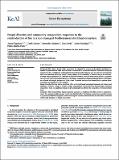Por favor, use este identificador para citar o enlazar a este item:
http://hdl.handle.net/10261/329542COMPARTIR / EXPORTAR:
 SHARE SHARE
 CORE
BASE CORE
BASE
|
|
| Visualizar otros formatos: MARC | Dublin Core | RDF | ORE | MODS | METS | DIDL | DATACITE | |

| Título: | Fungal diversity and community composition responses to the reintroduction of fire in a non-managed Mediterranean shrubland ecosystem |
Autor: | Espinosa, Juncal; Dejene, Tatek; Guijarro Guzmán, Mercedes; Cerdá, Xim CSIC ORCID ; Madrigal Olmo, Javier; Martín-Pinto, Pablo | Palabras clave: | Doñana National Park Ectomycorrhizal fungi Fire ecology Forest management Global change Prescribed burning Saprotrophic fungi Wildfire |
Fecha de publicación: | 13-abr-2023 | Editor: | Elsevier | Citación: | Forest Ecosystems 10: e100110 (2023) | Resumen: | Background: More than a decade of fire suppression has changed the structure of fire-adapted shrubland ecosystems in Spain's National Parks, which are now at extreme risk of uncontrolled wildfires. Prescribed burning can mitigate the risk of wildfires by reducing the fuel load but prescribed burning may also alter the soil properties and reduce microbial and fungal activity, causing changes in the availability of nutrients deep in the soil layer. Although fungal communities are a vital part of post-fire restoration, some fire effects remain unclear. To examine the short-term effects of prescribed burning on soil fungal communities in Doñana Biological Reserve (SW Spain), we collected soil samples pre-burn and 1 day, 6 and 12 months post-burn from burned plots to perform physicochemical and metabarcode DNA analyses. Results: Prescribed burning had no significant effect on the total fungal operational taxonomic unit richness and abundance. However, changes in soil pH, nitrogen and potassium content post-burn affected fungal community composition. Small non-significant changes in pH and phosphorous affected the composition of ectomycorrhizal fungi. Conclusions: The ectomycorrhizal fungal community appears to be resilient to the effects of low-to moderate-intensity fires and saprotrophic taxa may benefit from this kind of fire. This finding revealed that prescribed burning is a potentially valuable management tool for reducing fire hazards in shrublands that has little effect on the total richness and abundance of fungal communities. | Descripción: | 11 Pág. | Versión del editor: | https://doi.org/10.1016/j.fecs.2023.100110 | URI: | http://hdl.handle.net/10261/329542 | DOI: | 10.1016/j.fecs.2023.100110 | E-ISSN: | 2197-5620 |
| Aparece en las colecciones: | (INIA) Artículos |
Ficheros en este ítem:
| Fichero | Descripción | Tamaño | Formato | |
|---|---|---|---|---|
| Fungal_diversity_and_community.pdf | artículo | 2,2 MB | Adobe PDF |  Visualizar/Abrir |
CORE Recommender
SCOPUSTM
Citations
2
checked on 28-abr-2024
WEB OF SCIENCETM
Citations
2
checked on 26-feb-2024
Page view(s)
46
checked on 01-may-2024
Download(s)
58
checked on 01-may-2024
Google ScholarTM
Check
Altmetric
Altmetric
Este item está licenciado bajo una Licencia Creative Commons



